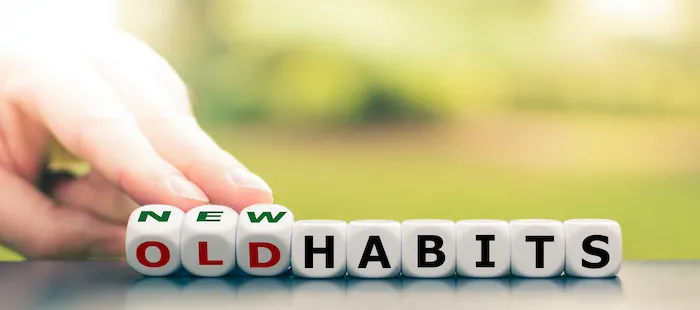Every day, you make countless choices — from the moment you wake up to the moment you go to bed. What you eat, how you move, how productive you are, even your mood, are all influenced by the environment around you.
While we often focus on willpower, discipline, or motivation to build habits, science shows that your surroundings — physical, social, and digital — play a more profound role than most people realize. You can have all the determination in the world, but if your environment constantly nudges you toward old behaviors, it becomes significantly harder to adopt new, positive habits.
In this article, we explore how your environment shapes your daily routines, why small adjustments can lead to big changes, and practical strategies to design spaces that support your goals, health, and well-being.
Table of contents
- 1. The Science of Environmental Influence
- 2. Physical Environment and Habits
- 3. Social Environment and Peer Influence
- 4. Digital Environment and Habit Formation
- 5. Environmental Triggers and Habit Loops
- 6. Minimalism and Decluttering for Better Habits
- 7. Environmental Design for Productivity
- 8. Behavioral Economics and Environmental Nudges
- 9. Habit Stacking and Environmental Anchoring
- 10. Mindful Spaces and Mental Health
- 11. Environmental Cues for Healthier Habits
- 12. Overcoming Environmental Challenges
- 13. Social and Community Design
- 14. Technology and Environmental Integration
- 15. The Ripple Effect of Environmental Change
- 16. Steps to Design Your Habit-Friendly Environment
- 17. Conclusion: Environment as the Silent Architect of Your Life
1. The Science of Environmental Influence
Behavioral scientists have long studied how context shapes habits. The key insight: humans are wired to respond to cues in their environment.
- Visual cues trigger automatic behaviors. For example, leaving a water bottle on your desk increases the likelihood of drinking water.
- Social cues affect decision-making. People mimic behaviors of peers, friends, or family, often unconsciously.
- Physical arrangements influence efficiency. A cluttered kitchen can reduce healthy meal preparation; a tidy, organized space can encourage productivity.
This is why changing your environment can be more effective than relying solely on willpower. By designing spaces that nudge you toward desired actions, you align your habits with your goals naturally.
2. Physical Environment and Habits
Your physical surroundings have a direct impact on your daily routines.
Home Environment
- Bedroom: The placement of your alarm clock, lighting, and even bed linens can affect sleep quality.
- Kitchen: Visibility of healthy foods encourages better nutrition, while keeping snacks out of sight reduces impulsive eating.
- Living Area: A clutter-free, organized space supports mental clarity and reduces stress.
Work Environment
- Desk Arrangement: Ergonomic setups promote posture and reduce fatigue, while a messy desk may decrease focus.
- Proximity to Tools: Placing work essentials within easy reach encourages productivity and reduces procrastination.
- Ambient Factors: Lighting, temperature, and noise levels can significantly affect mood, concentration, and energy levels.
Outdoor Environment
- Access to nature or green spaces encourages physical activity and reduces stress.
- Exposure to pollution, noise, or unsafe areas can increase anxiety and discourage exercise or outdoor routines.
Every environment is a constant cue that shapes your habits, often in subtle, unnoticed ways.
3. Social Environment and Peer Influence
Your behavior is highly influenced by the people around you. Social norms, peer behavior, and community expectations can reinforce or undermine habits.

- Positive Influence: Surrounding yourself with health-conscious, motivated, or supportive people makes it easier to adopt similar habits.
- Negative Influence: Constant exposure to procrastination, unhealthy eating, or sedentary lifestyles can normalize these behaviors.
- Digital Social Cues: Social media, group chats, and online communities also shape habits, both positively (fitness challenges) and negatively (doomscrolling, unhealthy comparisons).
Your social environment acts as both a mirror and a guide — it can either support your growth or subtly reinforce old patterns.
4. Digital Environment and Habit Formation
We live in a digital age where screens dominate attention. The apps, notifications, and devices we interact with daily are powerful habit shapers.
- Notifications: Constant alerts fragment attention and reinforce reactive behavior.
- Content Algorithms: Social media and streaming platforms are designed to maximize engagement, often encouraging prolonged, passive consumption.
- Accessibility of Tools: Digital calendars, fitness apps, and reminders can support positive habits if structured intentionally.
Designing your digital environment — muting unnecessary notifications, setting app limits, and curating content — is crucial for maintaining focus and supporting healthy routines.
5. Environmental Triggers and Habit Loops
Habits often form as cue → routine → reward loops. The environment provides the cues that trigger behaviors:
- Cue: Seeing running shoes by the door.
- Routine: Going for a jog.
- Reward: Endorphin release and sense of accomplishment.
By consciously modifying cues in your environment, you can make positive habits more automatic and negative habits less likely.
Examples:
- Placing a book on your pillow encourages nightly reading.
- Hiding the TV remote can reduce mindless screen time.
- Leaving a yoga mat visible in your living room increases the likelihood of exercising.
Small adjustments can dramatically shift behavior over time, because habits are largely context-driven.
6. Minimalism and Decluttering for Better Habits
Minimalist environments encourage focus and intentionality. A cluttered space creates cognitive overload, making it harder to follow healthy routines.
- Physical Clutter: Excess items distract attention, induce stress, and promote procrastination.
- Digital Clutter: Overcrowded desktops, files, and app notifications fragment focus.
- Mental Clutter: Unorganized tasks and reminders create decision fatigue.
Decluttering and simplifying your environment allows your brain to devote energy to meaningful habits instead of constant navigation of distractions.
7. Environmental Design for Productivity
Designing an environment for productivity is about aligning your space with desired outcomes.
- Work Zones: Designate areas for specific activities — a desk for work, a corner for reading or creative pursuits.
- Lighting and Sound: Natural light boosts mood and energy; background music or ambient noise can enhance focus for some tasks.
- Accessibility of Resources: Keep essential tools close, remove unnecessary distractions, and create visual reminders of priorities.
- Movement-Friendly Layout: Spaces that encourage stretching, walking, or standing improve physical health and cognitive performance.
Small changes in how your environment is structured can dramatically increase efficiency and reinforce productive habits.
8. Behavioral Economics and Environmental Nudges
Environmental design can leverage insights from behavioral economics — the study of how context influences decision-making.
- Default Options: Placing healthy food at eye level nudges better choices.
- Immediate Rewards: Visual feedback, such as a habit tracker, reinforces consistency.
- Choice Architecture: Simplifying decisions and reducing friction increases adherence to desired habits.
- Reducing Temptation: Keeping distractions out of sight lowers the likelihood of indulgence.
By structuring your surroundings to make positive actions easier and negative actions harder, you create a supportive environment for habit formation.
9. Habit Stacking and Environmental Anchoring
Habit stacking involves linking new behaviors to existing ones, often using environmental cues as anchors.
Example:
- After brushing your teeth (existing habit), you immediately drink a glass of water (new habit).
- Leaving resistance bands by your bed allows stretching immediately after waking.
- Setting your phone across the room anchors morning meditation without distraction.
Environmental anchors make new routines more automatic and reduce reliance on willpower.
10. Mindful Spaces and Mental Health
Your environment affects emotional well-being, which in turn impacts habits:
- Natural Elements: Plants, sunlight, and fresh air reduce stress and improve focus.
- Personalization: Spaces that reflect personal identity increase comfort and motivation.
- Quiet Zones: Areas free from distractions support deep work, meditation, or reflection.
- Color Psychology: Certain colors influence mood — blues can calm, greens refresh, yellows energize.
Mindfully designed environments create spaces that nurture both mental health and positive routines.
11. Environmental Cues for Healthier Habits
Small environmental tweaks can reinforce wellness:

- Nutrition: Pre-cut vegetables in clear containers increase vegetable consumption.
- Exercise: Gym clothes laid out or a visible yoga mat encourages physical activity.
- Sleep: Blackout curtains, cool temperatures, and removing electronics from the bedroom enhance rest.
- Hydration: Water bottles in sight prompt regular drinking.
By engineering your environment for success, habits become almost effortless.
12. Overcoming Environmental Challenges
Sometimes environments are constraining rather than supportive:
- Workplaces with high distractions can be mitigated by noise-canceling headphones or focused time blocks.
- Shared living spaces require negotiation and creative design to maintain personal routines.
- Urban settings with limited nature can be countered with indoor plants, balcony gardens, or scheduled outdoor walks.
Even small adjustments can create powerful habit-supporting environments despite external constraints.
13. Social and Community Design
Beyond personal spaces, communities shape behaviors:
- Fitness Communities: Local running clubs or yoga groups create accountability.
- Peer Challenges: Friends sharing wellness goals reinforce consistency.
- Neighborhood Infrastructure: Walkable streets, bike paths, and parks encourage active lifestyles.
Social and physical community environments amplify personal habit formation, making healthy routines socially normative.
14. Technology and Environmental Integration
Technology can complement physical environments to reinforce habits:
- Smart Home Devices: Lights that dim for sleep, reminders for movement, and smart fridges for food tracking.
- Habit Tracking Apps: Visual charts and streaks reinforce consistency.
- Digital Detox Settings: Scheduled downtime and app limits reduce distractions and negative routines.
Blending digital and physical environments creates a holistic ecosystem that promotes positive habits.
15. The Ripple Effect of Environmental Change
Changing your environment not only influences personal habits but also creates a ripple effect:
- Family members and roommates adopt healthier routines when spaces are organized or active.
- Positive environmental cues in offices improve overall team productivity.
- Communities with walkable streets, green spaces, and accessible healthy food promote collective well-being.
Small environmental changes can propagate widely, creating systemic benefits.
16. Steps to Design Your Habit-Friendly Environment
Practical steps to cultivate an environment that supports positive habits:
- Audit Your Spaces: Identify cues that trigger undesirable habits and opportunities for positive cues.
- Declutter and Organize: Reduce friction for desired behaviors.
- Set Visible Reminders: Notes, objects, or tools that prompt action.
- Leverage Social Support: Surround yourself with supportive peers and communities.
- Use Technology Wisely: Habit trackers, smart devices, and reminders reinforce routines.
- Experiment and Adapt: Test changes and observe which environmental adjustments work best for you.
Even incremental changes can create a substantial cumulative impact over time.
17. Conclusion: Environment as the Silent Architect of Your Life
Your environment silently orchestrates your daily behaviors. From physical spaces to social circles, from digital feeds to community design, every cue shapes your routines, decisions, and ultimately your life trajectory.
By consciously designing environments that support positive habits, you reduce reliance on willpower, boost consistency, and cultivate a lifestyle aligned with your goals. Mindful adjustment of your surroundings transforms habits from fleeting efforts into effortless, sustainable patterns.
The power to shape your daily life isn’t found in sheer discipline alone — it’s embedded in the spaces, people, and contexts that surround you. Create environments that nurture your best self, and watch your habits — and your life — flourish.
